reset GMC JIMMY 1997 Owner's Manual
[x] Cancel search | Manufacturer: GMC, Model Year: 1997, Model line: JIMMY, Model: GMC JIMMY 1997Pages: 410, PDF Size: 20.03 MB
Page 101 of 410
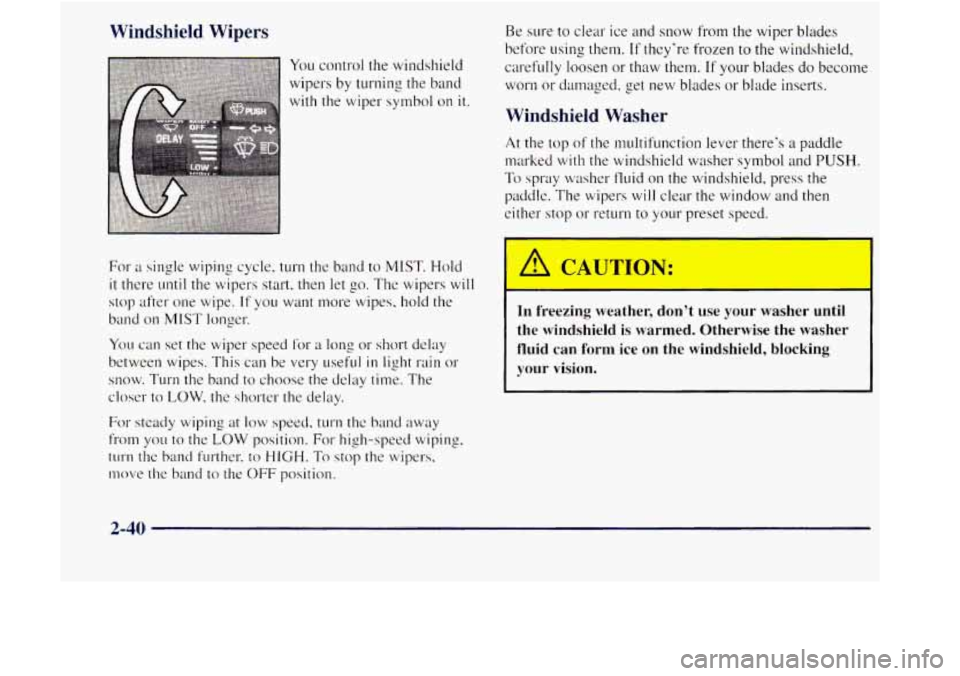
Windshield Wipers
You control the windshield
wipers
by turning the band
with the wiper symbol
on it.
For a single wiping cycle. turn the band to MIST. Hold
it there until the wipers start. then let go. The wipers will
stop after one wipe. If you want Inore wipes, hold the
band on
MIST longer.
You can set the wiper speed I‘or a long or short delay
between wipes. This can be very
LIS~~LII in light rain or
snow. Turn the band to choose the delay time. The
closer to
LOW, the shorter the delay.
Be sure to ciear ice and snow from the wiper blades
before using them. If they’re frozen to the windshield,
carefully loosen or thaw them.
If your blades do become
worn or datnaged.
set new blades or blade inserts.
Windshield Washer
At the top of the multifunction lever there’s a paddle
marked with the windshield washer
symbol and PUSH.
To spray washer fluid on the windshield, press the
paddle. The wipers
will clear the window and then
either stop or return to your preset speed.
I
I
A C iTJTION:
In freezing weather, don’t use your washer until
the windshield is warmed. Otherwise the washer
fluid can
form ice an the windshield, blocking
your vision.
2-40
Page 104 of 410
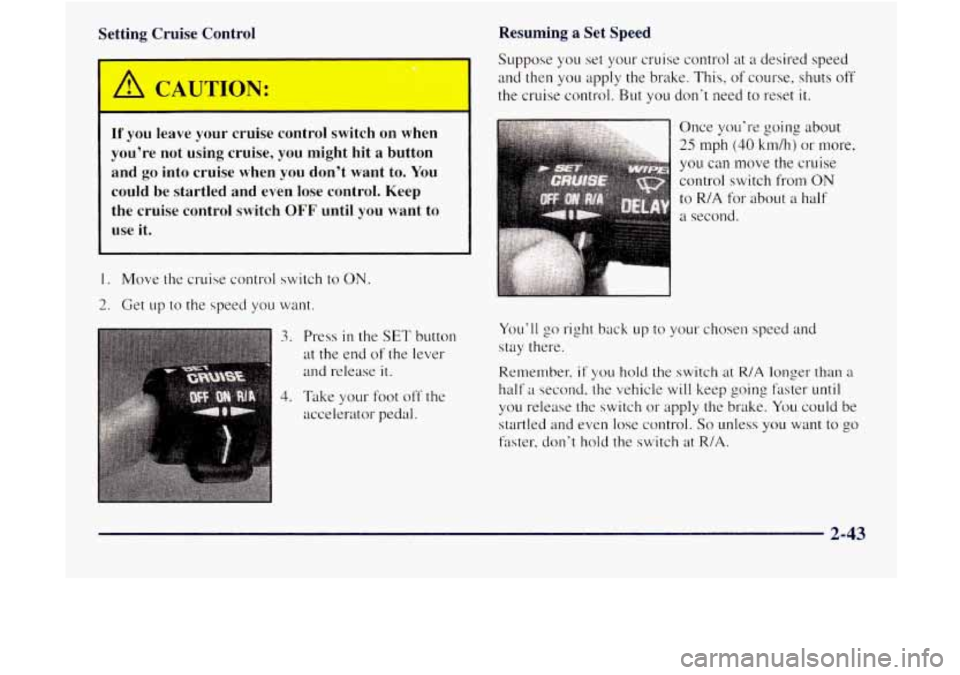
Setting Cruise Control
I
If you leave your cruise control switch on when
you’re not using cruise, you might hit a button
and
go into cruise when you don’t want to. You
could be startled and even lose control. Keep
the cruise control switch
OFF until you want to
use it.
1 - Move the cruise control switch to ON.
2. Get up to the speed you want.
3. Press in the SET button
at the end
of the lever
and release
it.
4. TLlke your foot oft’ the
accelerator pedal.
Resuming a Set Speed
Suppose you set your cruise control at a desired speed
and then
you apply the brake. This, of course, shuts off
the cruise control. But you don’t ne.ed to reset it.
Once. you’re going
about
25 mph (40 kmh) or nnore,
you can move the cruise
control switch from
ON
to R/A for about a half
a second.
You’ll go right back LIP to your chosen speed and
stay there.
Ren~ember. if you hold the switch at R/A longer than a
half a second, the vehicle will keep going faster until
you release the switch or apply the brake. You could be
startled and even lose control. So unless you want to go
faster. don‘t hold the switch at R/A.
2-43
Page 116 of 410

The compass is self-calibrating, so it does not need
to be manually set. However. if C (Calibration) is
displayed, the compass will need to be calibrated.
You may also place the compass
in a noncalibrated
Inode by pressing and holding
the MODE and US/MET
buttons simultaneously while
in the COMP/TEMP
mode. After about
10 seconds, the compass will display
C and
you can release the buttons. Drive the vehicle in
a complete 360" circle three times at a speed of less
than
5 mph (8 km/h), and the compass will function
nor~nally. Once the calibration is complete, the display
will return to a compass reading.
Variance is the difference between magnetic north and
the two can be great enough to cause false compass
readings.
If this happens. follow these instructions to
set the variance for your particular location:
I. Find your location on the zone map earlier in this
2. Press and hold both the MODE and the USNET
z oeographic north. In some areas, the difference between
section. Note your zone number.
buttons
in the COMP/TEMP mode.
3. After five seconds, the compass will acknowledge
the variation mode
by displaying the cuwent zone
number. When it does, release both buttons.
4. Press US/MET until your zone number appears
on the display.
5. Press MODE to enter your zone number. Your
variance is now set and the display
will return to
the COMP/TEMP mode.
TRIP: Once in the TRIP mode. pressing the
MODE button will step you through the following
TRIP functions:
0
0
0
0
0
To
AVG ECON: The average fuel economy since the
last reset is displayed.
INST ECON: Instantaneous fuel economy for the
last second
of driving is displayed.
RANGE: The display indicates the estimated
distance that can be travelled with the remaining
fuel
in the tank, based on the fuel economy for the
last few hours of driving.
FUEL USED: The fuel used since the last reset
is displayed.
AVCJ SPEED: The average speed since the last
reset is displayed.
reset the
trip computer. press the MODE and
US/MET butt& silnultaneously for at least two
seconds.
All functions will be displayed for half a
second once the system is reset.. Reset can only be
performed
in the AVG ECON. FUEL USED and
AVG
SPEED modes. All three modes are reset
silnultaneously.
2-55
Page 150 of 410
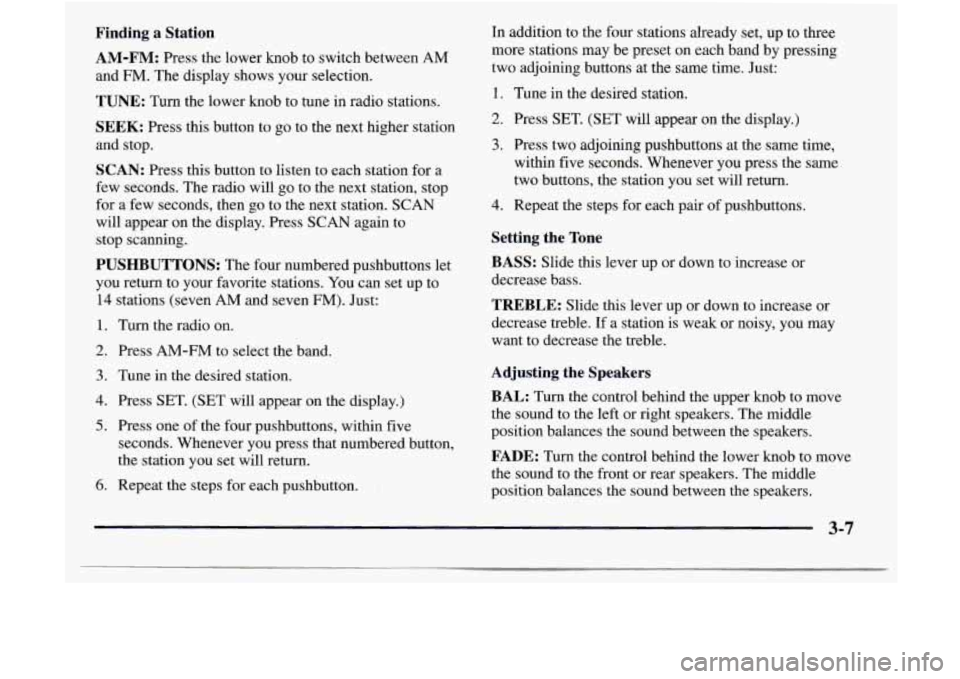
Finding a Station
AM-FM:
Press the lower knob to switch between AM
and
FM. The display shows your selection.
TUNE: Turn the lower knob to tune in radio stations.
SEEK: Press this button to go to the next higher station
and stop.
SCAN: Press this button to listen to each station for a
few seconds. The radio will go
to the next station, stop
for a few seconds, then
go to the next station. SCAN
will appear on the display. Press SCAN again to
stop scanning.
PUSHBUTTONS: The four numbered pushbuttons let
you return to your favorite stations. You can set up to
14 stations (seven AM and seven FM). Just:
1. Turn the radio on.
2. Press AM-FM to select the band.
3. Tune in the desired station.
4. Press SET. (SET will appear on the display.)
5. Press one of the four pushbuttons, within five
seconds. Whenever you press that numbered button,
the station you set will return.
6. Repeat the steps for each pushbutton. In addition to the four stations already set,
up to three
more stations may be preset on each band by pressing
two adjoining buttons at the same time. Just:
1. Tune in the desired station.
2. Press SET. (SET will appear on the display.)
3. Press two adjoining pushbuttons at the same time,
within five seconds. Whenever you press the same
two buttons, the station you set will return.
4. Repeat the steps for each pair of pushbuttons.
Setting the Tone
BASS:
Slide this lever up or down to increase or
decrease bass.
TREBLE: Slide this lever up or down to increase or
decrease treble. If a station is weak or noisy, you may
want to decrease the treble.
Adjusting the Speakers
BAL:
Turn the control behind the upper knob to move
the sound to the left or right speakers. The middle
position balances the sound between the speakers.
FADE: Turn the control behind the lower knob to move
the sound to the front or rear speakers. The middle
position balances the sound between the speakers.
3-7
Page 152 of 410
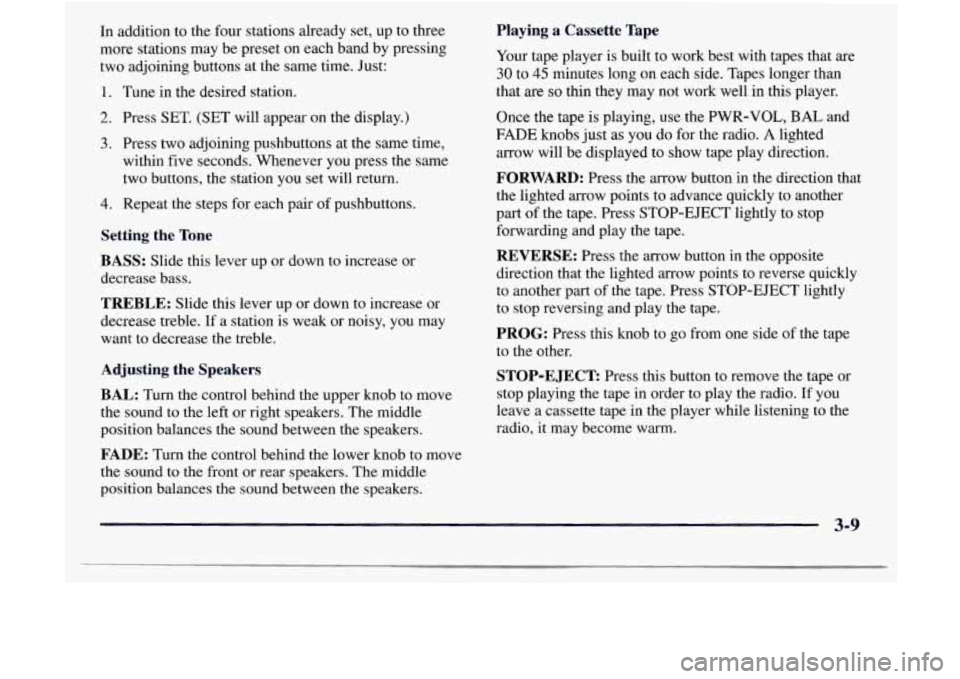
In addition to the four stations already set, up to three
more stations may be preset on each band by pressing
two adjoining buttons at the same time. Just:
1. Tune in the desired station.
2. Press SET. (SET will appear on the display.)
3. Press two adjoining pushbuttons at the same time,
within five seconds. Whenever you press the same
two buttons, the station you set will return.
4. Repeat the steps for each pair of pushbuttons.
Setting the Tone
BASS:
Slide this lever up or down to increase Or
decrease bass.
TREBLE: Slide this lever up or down to increase or
decrease treble.
If a station is weak or noisy, you may
want to decrease the treble.
Adjusting the Speakers
BAL:
Turn the control behind the upper knob to move
the sound to the left or right speakers. The middle
position balances the sound between the speakers.
FADE: Turn the control behind the lower knob to move
the sound to the front or rear speakers. The middle
position balances the sound between the speakers.
Playing a Cassette Tape
Your tape player is built to work best with tapes that are
30 to 45 minutes long on each side. Tapes longer than
that
are so thin they may not work well in this player.
Once the tape is playing, use the
PWR-VOL, BAL and
FADE knobs just as you do for the radio. A lighted
arrow will be displayed to show tape play direction.
FORWARD: Press the arrow button in the direction that
the lighted arrow points to advance quickly to another
part of the tape. Press STOP-EJECT lightly to stop
forwarding and play the tape.
REVERSE: Press the arrow button in the opposite
direction that the lighted
arrow points to reverse quickly
to another part of the tape. Press STOP-EJECT lightly
to stop reversing and play the tape.
PROG: Press this knob to go from one side of the tape
to the other.
STOP-EJECT: Press this button to remove the tape or
stop playing the tape in order to play the radio. If you
leave a cassette tape in the player while listening to the
radio, it may become warm.
Page 157 of 410

18
1.
2.
3.
4.
5.
PUSHBUTTONS: The six numbered pushbuttons let
you return to your favorite stations. You can set up to
6.
stations (six AM. six FM 1 and six FM2). Just:
Turn the radio on.
Press
AM-FM to select the band.
Tune
in the desired station.
Press
AUTO TONE to select the setting you prefcr.
Press and hold one
of the four pushbuttons. The
sound will
mute. When it returns. release the button.
Whenever
you press that numbered button, the
station
you set will return and the tone you selected
will be a~~tomatically selected for that button.
Repeat the steps
for each pushbutton.
P.SCAN: The preset scan button lets you scan through
your favorite stations stored
on your pushbuttons. Sele-ct
either the
AM, FMI or FM2 mode and then press
P.SCAN.
It will scan through each station stored on your
pushbuttons
and stop for ;I few seconds before
continuing to scan through a11
of the pushbuttons. Press
P.SCAN
again or one of the pushbuttons to stop
scanning to listen to a specific stored station. P.SCAN
will light up on the display while in this mode. If one of
the stations stored on a pushbutton is too weak for the
location you
itre in, the radio will skip the preset station
and the radio display will show the channel number
(PI through
P6) for several seconds before advancing to
the next preset station.
Page 285 of 410
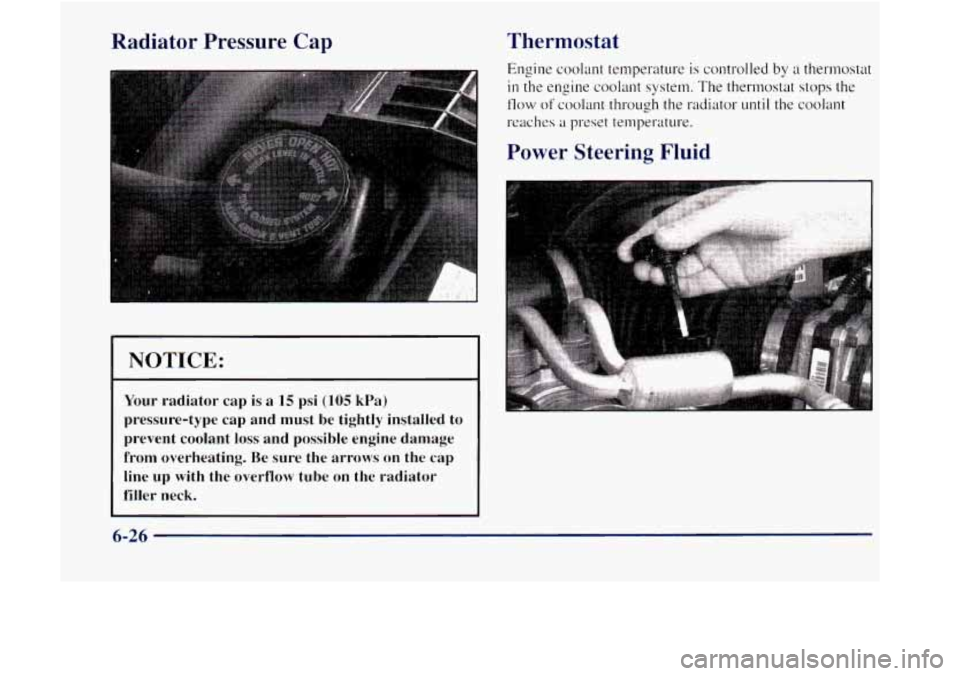
Radiator Pressure Cap
NOTICE:
Your radiator cap is a 15 psi (105 kPa)
pressure-type cap and must be tightly installed to
prevent coolant
loss and possible engine damage
fronl overheating. Be sure the arrows
on the cap
line up with the overflow tube on the radiator
filler neck.
Thermostat
Engine coolant temperattrre is controlled by a thermostat
in the engine coolant system. The thermostat stops the
flow of coolant through the radiator until the coolant
reaches
a preset temperature.
Power Steerinp Fluid
6-26